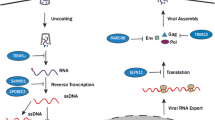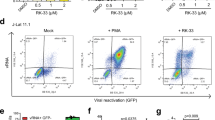Abstract
Use of combination anti-retroviral drug regimens including protease inhibitors dramatically decreased morbidity and mortality rates in HIV-1 infected individuals. However, such combination therapies appear to have many side effects, in addition to the emergence of resistant HIV-1 strains. Therefore, in this study we sought to elucidate novel therapeutic principles against HIV-1 infection. We examined the effects of electrical stimulation on both chronically HIV-1LAI infected HeLa cells (P6 HeLa/HIV-1LAI) and uninfected cells (P6 HeLa). Cells were cultured on an optically transparent electrode and application of potential at 1.0 V vs Ag/AgCl was performed over time periods ranging from 10 min to 60 min. Both P6 HeLa/HIV-1LAI and P6 HeLa cells were progressively damaged as the duration of electrical stimulation increased. However, P6 HeLa/HIV-1LAl cells were much more influenced by electrical stimulation than P6 HeLa cells. The difference in damage rate was most obvious at 30 min of electrical stimulation, with damaged cells accounting for about 87% and 4% of P6 HeLa/HIV-1LAI and P6 HeLa cells, respectively. After the application of potential for 20 min, the proliferation of P6 HeLa/HIV-1LAI cells was markedly inhibited, while the P6 HeLa cells proliferated to an extent similar to that of uninfected cells without application of potential. These results indicate that sensitivity to electrical stimulation is much higher in chronically HIV-1 infected cells than in uninfected cells. This could be considered as a useful new approach against HIV-1 infection.





Similar content being viewed by others
References
Aizawa M, Koyama S, Kimura K, Haruyama T, Yanagida Y, Kobatake E (1999) Electrically stimulated modulation of cellular function in proliferation, differentiation, and gene expression. Electrochemistry 67:118–125
Barré-Sinoussi F, Chermann JC, Rey F, Nugeyre MT, Chamaret S, Gruest J, Dauguet C, Axler-Blin C, Vézinet-Brun F, Rouzioux C, Rozenbaum W, Montagnier L (1983) Isolation of a T-lymphotropic retrovirus from a patient at risk for acquired immune deficiency syndrome (AIDS). Science 220:868–871
Berg H, Augsten K, Bauer E, Förster W, Jacob H-E, Mühlig P, Weber H (1984) Possibilities of cell fusion and transformation by electrostimulation. Bioelectrochem Bioenerg 12:119–133
Cameron DW, Heath-Chiozzi M, Danner S, Cohen C, Kravcik S, Maurath C, Sun E, Henry D, Rode R, Potthoff A, Leonard J (1998) Randomised placebo-controlled trial of ritonavir in advanced HIV-1 disease. Lancet 351:543–549
Carr A, Samaras K, Burton S, Law M, Freund J, Chisholm DJ, Copper DA (1998) A syndrome of peripheral lipodystrophy, hyperlipidaemia and insulin resistance in patients receiving HIV protease inhibitors. AIDS 12:F51–F58
Chrystie IL, Almeida JD (1988) Further studies of HIV morphology by negative staining. AIDS 2:459–464
Colgrove RC, Pitt J, Chung PH, Welles SL, Japour AJ (1998) Selective vertical transmission of HIV-1 antiretroviral resistance mutations. AIDS 12:2281–2288
Gallo RC, Salahuddin SZ, Popovic M, Shearer GM, Kaplan M, Haynes BF, Palker TJ, Redfield R, Oleske J, Safai B, White G, Foster P, Markham PD (1984) Frequent detection and isolation of cytopathic retroviruses (HTLV-III) from patients with AIDS and risk for AIDS. Science 224:500–503
Gottlieb MS, Schroff R, Schanker HM, Weisman JD, Fan PT, Wolf RA, Saxon A (1981) Pneumocystis carinii pneumonia and mucosal candidiasis in previously healthy homosexual men. Evidence of a new acquired cellular immunodeficiency. N Engl J Med 305:1425–1431
Hogg SR, O'Shaughnessy MV, Gataric N, Yip B, Craib K, Schechter MT, Montaner JSG (1997) Decline in deaths from AIDS due to new antiretroviral. Lancet 349:1294
Kojima J, Shinohara H, Ikariyama Y, Aizawa M, Nagaike K, Morioka S (1992) Electrically promoted protein production by mammalian cells cultured on the electrode surface. Biotechnol Bioeng 39:27–32
Mie M, Ohgushi H, Haruyama T, Kobatake E, Aizawa M (1996) Electrically enhanced osteogenic differentiation of rat bone marrow stromal stem cells. Cell Eng 1:153–158
Morizono K, Harada S (1998) Human immunodeficiency virus type 1 (HIV-1) infection and transcytosis activity of a HIV-1 susceptible clone from HeLa cells. Microbiol Immunol 42:313–320
Palella FJ, Delaney KM, Moorman AC, Loveless MO, Fuhrer J, Satten GA, Aschman DJ, Holmberg SD, HIV outpatient study investigators (1998) Declining morbidity and mortality among patients with advanced human immunodeficiency virus infection. N Engl J Med 338:853–860
Powell KT, Derrick EG, Weaver JC (1986) A quantitative theory of reversible electrical breakdown in bilayer membranes. Bioelectrochem Bioenerg 15:243–255
Sarmati L, Nicastri E, Parisi SG, d'Ettorre G, Mancino G, Narciso P, Vullo V, Andreoni M (2002) Discordance between genotypic and phenotypic drug resistance profiles in human immunodeficiency virus type 1 strains isolated from peripheral blood mononuclear cells. J Clin Microbiol 40:335–340
Tominaga M, Kumagai T, Takita S, Taniguchi I (1993) Effect of surface hydrophilicity of an indium oxide electrode on direct electron transfer of myoglobins. Chem Lett 1771–1774
Tominaga M, Kumagai E, Harada S (2003) Effect of electrical stimulation on HIV-1-infected HeLa cells cultured on an electrode surface. Appl Microbiol Biotechnol 61:447–450
Yaoita M, Aizawa M, Ikariyama Y (1989) Electrically regulated cellular morphological and cytoskeletal change on an optically transparent electrode. Exp Cell Biol 57:43–51
Zimmerman U (1982) Electric field-mediated fusion and related electrical phenomena. Biochim Biophys Acta 694:227–277
Zimmerman U, Pilwat G, Riemann F (1974) Dielectric breakdown of cell membranes. Biophys J 14:881–899
Acknowledgements
We thank Ms. Y. Turu, Ms. A. Hara, Ms. S. Douki, and Ms. S. Mizukami of Kumamoto University College of Medical Science for technical support.
Author information
Authors and Affiliations
Corresponding author
Rights and permissions
About this article
Cite this article
Kumagai, E., Tominaga, M. & Harada, S. Sensitivity of chronically HIV-1 infected HeLa cells to electrical stimulation. Appl Microbiol Biotechnol 63, 754–758 (2004). https://doi.org/10.1007/s00253-003-1410-8
Received:
Revised:
Accepted:
Published:
Issue Date:
DOI: https://doi.org/10.1007/s00253-003-1410-8




